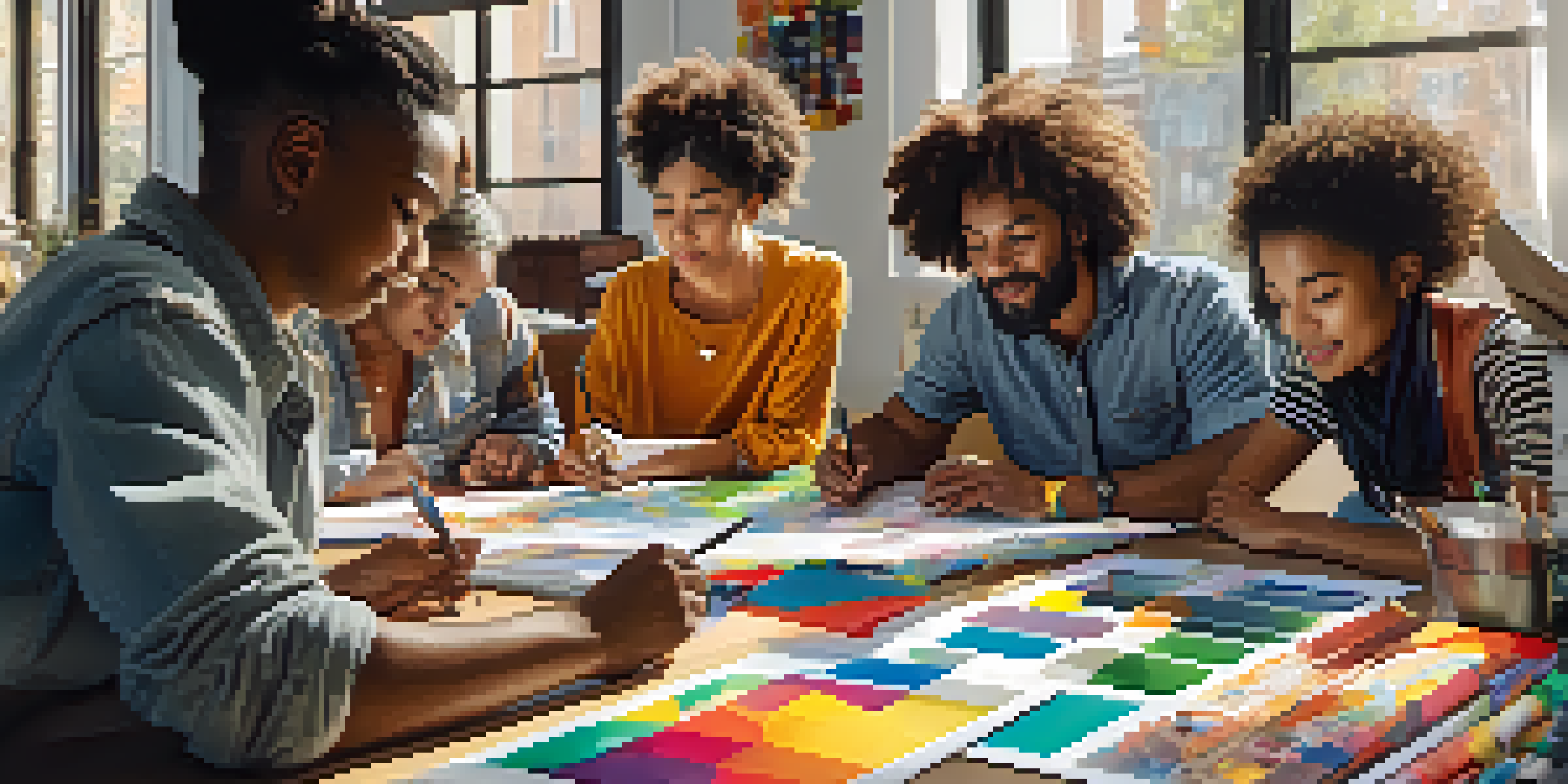Encouraging Creativity Through Collaborative Learning Projects

Understanding Collaborative Learning's Impact on Creativity
Collaborative learning is an approach where individuals work together to solve problems or create projects. This method fosters a sense of community and shared responsibility, which are key ingredients for nurturing creativity. When people come together, they bring different perspectives and ideas, sparking innovative thoughts that might not arise in isolation.
Alone we can do so little; together we can do so much.
Think of it like a potluck dinner: each person brings their unique dish to the table, resulting in a diverse and flavorful feast. In the same way, collaborative projects allow participants to contribute their strengths, creating a rich environment for creativity to flourish. This blend of ideas not only enhances the final outcome but also encourages participants to think outside their usual boundaries.
Moreover, the dynamics of teamwork can lead to constructive feedback, which is crucial for creative development. When individuals feel safe to share their thoughts, they are more likely to take risks and explore new concepts. This supportive atmosphere is what makes collaborative learning such a powerful tool for fostering creativity.
Setting Up Successful Collaborative Learning Projects
To kickstart a collaborative learning project, it's essential to establish clear goals and expectations. By outlining what you want to achieve, participants can align their efforts and stay focused. This clarity not only helps in managing tasks but also empowers individuals to take ownership of their contributions.

Another important aspect is to mix diverse skill sets within teams. When people with different backgrounds and expertise come together, they can tackle challenges from various angles. This diversity can lead to unexpected solutions and innovative ideas, enhancing the overall creative process.
Collaborative Learning Boosts Creativity
Working together allows individuals to share diverse ideas, fostering a rich environment for creativity.
Lastly, encourage open communication among team members. Creating a culture where everyone feels comfortable sharing ideas and feedback can significantly impact the project's success. Regular check-ins and brainstorming sessions can help maintain momentum and ensure that creativity continues to flow throughout the project.
The Role of Technology in Collaborative Learning
In today's digital age, technology plays a pivotal role in facilitating collaborative learning. Tools like shared documents, project management software, and communication platforms allow teams to collaborate seamlessly, regardless of geographical boundaries. This accessibility means that diverse minds can come together easily, enhancing creativity.
Creativity is thinking up new things. Innovation is doing new things.
Consider platforms like Google Docs or Trello, which enable multiple users to contribute and edit in real-time. These tools not only streamline the process but also ensure that every voice is heard. The ability to visualize progress and ideas collectively can spur creativity and keep everyone engaged.
Moreover, technology can provide access to a wealth of resources and inspiration. Online forums, educational videos, and collaborative brainstorming apps can enrich the learning experience. By leveraging these tools, teams can expand their horizons and draw upon a broader range of influences, further igniting their creative spark.
Overcoming Challenges in Collaborative Projects
While collaborative learning offers numerous benefits, it’s not without its challenges. Conflicts may arise when team members have differing opinions or work styles, which can hinder the creative process. It’s important to address these issues promptly and constructively to maintain a positive atmosphere.
One effective strategy is to establish ground rules for communication and conflict resolution early on. By setting expectations about respectful dialogue and feedback, teams can navigate disagreements more smoothly. This proactive approach not only minimizes disruptions but also fosters a culture of understanding and collaboration.
Technology Enhances Team Collaboration
Digital tools facilitate seamless collaboration, enabling teams to communicate and innovate effectively.
Additionally, encouraging flexibility and adaptability can help teams overcome obstacles. Creativity often thrives in environments where individuals can pivot and explore new directions. By embracing change and viewing challenges as opportunities, teams can turn potential setbacks into moments of growth and innovation.
Incorporating Play and Exploration into Learning
Creativity often flourishes in playful environments where exploration is encouraged. Integrating elements of play into collaborative learning projects can help break down barriers and stimulate innovative thinking. Activities like brainstorming games or creative challenges can make the process more engaging and enjoyable.
For instance, using techniques like mind mapping or role-playing can help participants visualize problems and solutions in a fun, interactive way. This playful approach not only boosts morale but also encourages individuals to think more freely and creatively. When the pressure is off, people are often more willing to experiment with new ideas.
Moreover, incorporating exploration into learning projects allows teams to discover new interests and passions. By giving participants the freedom to pursue their curiosity, you create a rich environment for creativity to thrive. This sense of discovery not only enhances the project but also fosters a love for learning that extends beyond the task at hand.
Evaluating the Success of Collaborative Projects
Evaluating the success of collaborative projects can be a subjective process, but there are key indicators to consider. One of the most important is the level of engagement and participation among team members. High levels of enthusiasm and contribution often signal that the project is fostering creativity effectively.
Another factor to assess is the quality of the final output. Did the project meet its initial goals? Were the ideas innovative and well-developed? Gathering feedback from all participants can provide valuable insights into what worked well and what could be improved for future projects.
Playfulness Drives Innovative Thinking
Incorporating playful elements in projects encourages exploration and frees individuals to think creatively.
Finally, consider the relationships built during the project. Successful collaboration often leads to stronger team bonds and a deeper appreciation for diverse perspectives. These connections can enhance future collaborations, creating a cycle of creativity and teamwork that benefits everyone involved.
Real-Life Examples of Collaborative Learning Success
One inspiring example of collaborative learning in action is the 'Hackathon' format, where individuals come together to create solutions over a short period. These events, often focused on technology or social issues, showcase how diverse teams can innovate rapidly. Participants often leave with not just new ideas but also a sense of accomplishment and camaraderie.
Another great illustration comes from educational institutions that use project-based learning. Schools often assign group projects that require students to work together, enhancing their problem-solving skills while sparking creativity. These projects can lead to remarkable outcomes, such as community initiatives or innovative presentations, showing the power of collaboration in education.

These real-life examples highlight that when people collaborate, they can achieve extraordinary results. By learning from these scenarios, we can better understand how to implement effective collaborative projects that inspire creativity and foster teamwork in various settings.